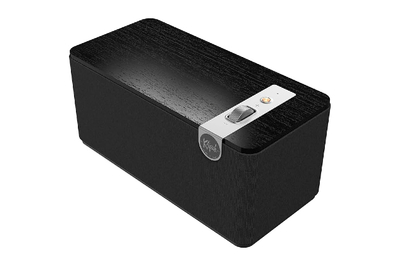The 3 Best Home Bluetooth Speakers of 2025

Top pick
Klipsch’s The One Plus is the ideal tabletop speaker for anyone who wants a simple, compact, great-sounding, good-looking option for their home or office.
Our listeners loved its combination of solid performance and reasonable price. In terms of sound quality alone, the One Plus wasn’t our overall favorite—that honor goes to our upgrade pick, the Morel Högtalare. But when we took price and size into account, this Klipsch speaker is the one we’d likely buy.
The big selling point of the One Plus’s sound is its clarity, especially with voices. We also thought it was especially easy to pick out the sounds of different instruments, even on complex orchestral recordings.
Although the One Plus’s bass doesn’t shake the couch the way some of the larger models we tested do, it does produce an impressive amount of bass for its size. If you want more bass in a similar package, Klipsch’s The Three Plus is basically the same speaker with a larger woofer and more features.
The One Plus hit 97.1 dB in our maximum volume test, which is plenty to fill a medium-size room—although a noticeable 4.1 dB less loud than the Morel Högtalare.
It’s simple to operate. Because the One Plus has just two controls—a button for power on/off and source selection, plus a volume knob—it should be easy for most people to use.
There’s a 3.5 mm analog input jack on the back, so you can connect an outboard audio player, such as a TV, an Amazon Echo Dot, or a turntable with a built-in phono preamp. You also get a USB-C jack for connecting smartphones, tablets, computers, and USB-C thumb drives.

The One Plus has two improvements over its predecessor, the now-discontinued One II, that make it easier to use. First, it uses an internal power supply rather than a wall wart, so there’s one less component to keep track of.
Also, its volume control works in sync with the volume control of the connected Bluetooth device, which means you don’t have to worry about both volume controls being turned up to a usable level. Unfortunately, the syncing isn’t reliable when the USB-C input is used; it works sometimes, and other times not.
There’s also a broadcast mode that lets you connect “10+” One Plus speakers wirelessly for multiroom sound with Bluetooth sources, but we weren’t able to test this.
We measured Bluetooth range at 110 feet through one window, using a Samsung Galaxy S10 phone. That’s an excellent result; it suggests you should be able to carry the phone around a typical suburban home without losing the wireless connection.
It’s small and stylish. At 6 by 12.6 by 6 inches, the One Plus is small enough to fit on most bookshelves and nightstands. The retro look and the simple control layout give it a sleek, unintimidating, non-techy vibe.
It’s available in walnut with a gray fabric grille (as shown in our photos) or in basic black.
Flaws but not dealbreakers
Some listeners might want more bass. The One Plus had plenty of bass for our taste, and we thought its sound was well-balanced. But if you’re looking for something that gets your couch vibrating a bit, and that can convey the full range of bass-heavy music such as hip-hop and R&B, we’d recommend you check out larger speakers like our upgrade pick or best-for pick.
The controls sometimes annoyed us a bit. There’s no way to start or stop playback from the speaker, which is a feature many Bluetooth speakers offer and one that’s especially convenient for home use. Also, you have to hold the power button down for five seconds to turn the unit off, which is inconveniently long.
Playback from USB-C thumb drives is kludgy. You have to push the reset button on the back of the speaker to play USB music files. Once they’re playing, you can start and stop playback using the reset button, but we couldn’t find a way to skip tracks, or to play any type of file other than MP3s.







